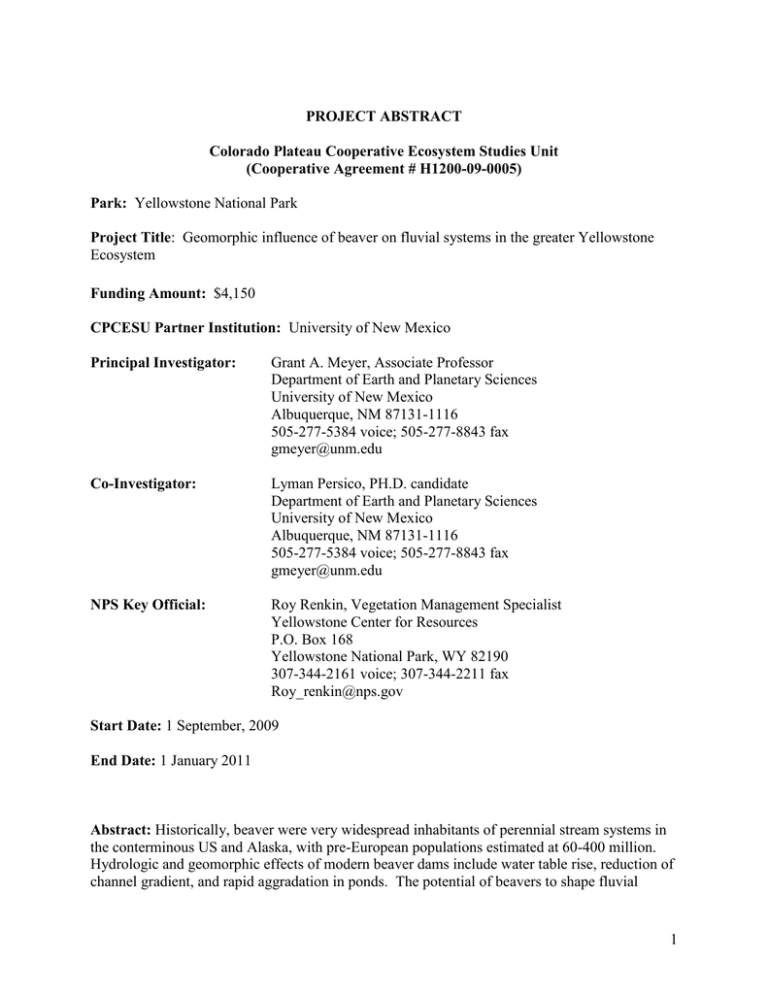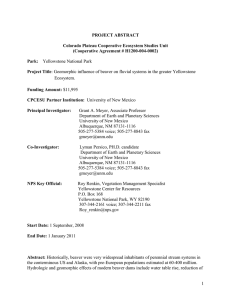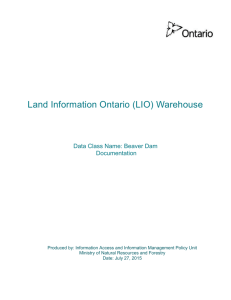UNM-32
advertisement

PROJECT ABSTRACT Colorado Plateau Cooperative Ecosystem Studies Unit (Cooperative Agreement # H1200-09-0005) Park: Yellowstone National Park Project Title: Geomorphic influence of beaver on fluvial systems in the greater Yellowstone Ecosystem Funding Amount: $4,150 CPCESU Partner Institution: University of New Mexico Principal Investigator: Grant A. Meyer, Associate Professor Department of Earth and Planetary Sciences University of New Mexico Albuquerque, NM 87131-1116 505-277-5384 voice; 505-277-8843 fax gmeyer@unm.edu Co-Investigator: Lyman Persico, PH.D. candidate Department of Earth and Planetary Sciences University of New Mexico Albuquerque, NM 87131-1116 505-277-5384 voice; 505-277-8843 fax gmeyer@unm.edu NPS Key Official: Roy Renkin, Vegetation Management Specialist Yellowstone Center for Resources P.O. Box 168 Yellowstone National Park, WY 82190 307-344-2161 voice; 307-344-2211 fax Roy_renkin@nps.gov Start Date: 1 September, 2009 End Date: 1 January 2011 Abstract: Historically, beaver were very widespread inhabitants of perennial stream systems in the conterminous US and Alaska, with pre-European populations estimated at 60-400 million. Hydrologic and geomorphic effects of modern beaver dams include water table rise, reduction of channel gradient, and rapid aggradation in ponds. The potential of beavers to shape fluvial 1 landscapes has long been recognized, leading some to propose that beaver damming is responsible for major valley filling over postglacial time. Because the magnitude and spatial and temporal extent of Holocene beaver-induced aggradation are largely unknown, impacts of historic beaver extirpation remain unclear. Very few data are available to explicitly address questions over long timescales important in fluvial system evolution. Given the critical importance of understanding beaver dam effects in stream restoration, we propose the first detailed study of Holocene geomorphic effects of beavers. In semiarid-subhumid landscapes of the greater Yellowstone ecosystem, beaver damming provides vitally important riparian habitat, but beaver populations were reduced or eliminated on many first- to fourth-order streams by the mid-20th century. We will investigate hydrologic and geomorphic conditions at Holocene and historic beaver dam sites to understand fundamental physical controls on dam location and longterm aggradation and incision. A further goal is to document and explain impacts of recent dam abandonment in the context of overall geomorphic and environmental change in greater Yellowstone, including recent warming and severe droughts that have reduced streamflows. We will conduct mapping, detailed stratigraphy, and AMS 14C dating of beaver pond and fluvial sediments to produce a chronology of beaver occupation and estimates of net beaver-related aggradation. These data will allow estimation of the volume and mass of valley-fill sediment stored as a result of Holocene beaver activity, and in fluvial deposits overall. Initial paleoclimatic comparisons indicate that beaver activity may be greatly reduced during lateHolocene multidecadal drought episodes. High-resolution valley-floor topography from LiDAR, GPS, and total-station surveys will complement this effort and provide accurate estimates of local valley and channel morphology and slope for geomorphic analysis. Initial results indicate that stream power limits potential beaver dam sites, thus discharge magnitude-frequency estimates will be derived by regional flood frequency analysis for stream power calculations. Detailed topographic data will also help to define terrace and floodplain morphology for understanding overall Holocene fluvial dynamics. Where stream reaches are currently incised, incision history will be dated using 14C, dendrochronology, and historic photos. Incision history and processes will be considered in light of the beaver-pond chronology, flood history, and other influences on channel conditions. Overall, the study will detail the spatial and long-term temporal extent of beaver-induced geomorphic change on smaller streams of greater Yellowstone, providing fundamental data necessary for planning restoration of thousands of kilometers of similar streams that may be impacted by loss of beaver across the interior western U.S. Keywords: Air / Weather / Noise Impacts on Ecosystem; Animals Mammals; Geology Sedimentology / Stratigraphy; Global Change / Climatology Effects on Plant and Animal Communities; Hydrology Hydrology of Riparian Habitats; Soil Riparian; Vegetation Riparian Habitats; Ecology/Ecosystems Resilience and Stability 2




